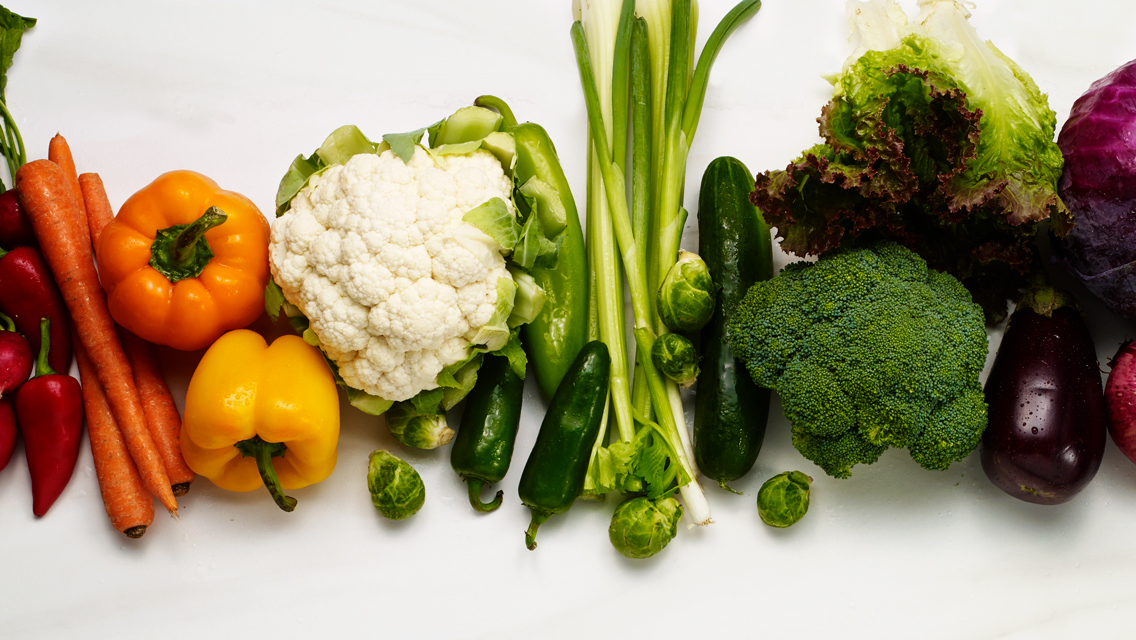Sections in this article:
3 Ways Vegetables Support Your Health ⋅ Pick Your Produce ⋅ 4 Strategies to Boost Your Veggie Intake
It’s a perennial question: How can I improve my eating habits? Food activist and journalist Michael Pollan famously counsels, “Eat food. Not too much. Mostly plants.” While clever and catchy, the lack of specificity can be vexing. What foods are acceptable? What’s too much? And when it comes to all those plants, how does “mostly” translate to the plate?
The 2015–2020 Dietary Guidelines for Americans (DGA) recommends 2 1/2 cups of vegetables per day. But many health experts believe the U.S. government sets the standards way too low.
“If you look around the world, [you realize] government agencies that have no relationships with food companies come up with very different recommendations,” observes Terry Wahls, MD, clinical professor of medicine at the University of Iowa Carver College of Medicine and author of The Wahls Protocol. “They advise much higher vegetable and fruit consumption.”
The Japanese government, for example, recommends 13 portions of vegetables and four portions of fruit daily. In France, it’s 10 servings of veggies and fruits.
In the United States, however, the Departments of Agriculture and Health and Human Services develop nutrition guidelines with input from groups such as the National Cattlemen’s Beef Association and the International Dairy Foods Association. Although the dietary-guidelines committee notes that these industry lobbyists offer only advice — not mandates — Wahls and others argue that the DGA guidelines are overly influenced by the special interests of these groups. (For more on the role the food industry plays in official health advice, see “Decoding Health Media.”)
Many health and nutrition experts want to raise the bar on eating veggies, challenging us to eat much more than the DGA advises. Wahls, for instance, advises her patients to eat 9 cups of vegetables — measured raw — per day (less for smaller-framed people and more for those addressing specific health issues).
Wahls advises her patients to eat 9 cups of vegetables — measured raw — per day.
Other experts advise levels that are higher than the current DGA recommendations, and most of them emphasize vegetables over fruits. For all of fruits’ nutritional virtues, including antioxidants, phytonutrients, and fiber, they can cause blood-sugar problems, such as elevated triglycerides, if regularly eaten in excess.
Americans currently consume an average of only 1 1/2 cups of veggies daily — half of which are potatoes and tomatoes, including fries and pizza sauce. Nine cups of vegetables may seem like an exceptionally tall order, but experts emphasize the nutritional and health benefits that only plants can provide. Plus, by focusing on eating more veggies, you’ll have less room for unhealthy foods.
Wahls can attest to the myriad health benefits her patients see when they shift to a plant-heavy diet. But her strongest testimonial is her own. (See “How Terry Wahls, MD, Beat Multiple Sclerosis (MS)” and upset the conventional medical world.)
In 2007, after several years of decline from progressive multiple sclerosis (MS), she was using a tilt/recline wheelchair and facing a dismal prognosis. As conventional treatments failed, Wahls researched alternative protocols, ultimately discovering a functional-medicine approach to treating complex chronic diseases that employs specific nutrients to support her health. Along with other therapeutic interventions, she eventually adopted an eating plan based on paleo principles, with an emphasis on large quantities of nutrient-rich vegetables.
It had a profound effect. In 2008 Wahls competed in an 18-mile bicycle race and started marathon training. Since 2010 she has been conducting clinical trials on her nutrition protocol — a cornerstone of which is consuming 9 cups of produce daily.
“If you change how you eat, you can change everything — physically, but also mentally and emotionally,” Wahls says. “This way of eating gave me my life back.”
If you’re intent on getting more plant-powered foods in your diet, read on.
3 Ways Vegetables Support Your Health
Wahls’s recovery powerfully illustrates the influence of food on health — and it’s a good reminder that nutrition does its most important work at the cellular level.
Cells issue the signals that affect how you think, feel, sleep, age, breathe, and operate. Their main power source, the mitochondria, helps them rejuvenate and function effectively. Proper nutrition is one of the keys to boosting mitochondrial health, with nutrient-dense, plant-based foods — particularly veggies — playing an important role.
While it might be tempting to pop supplements to get these nutrients, you’d miss out on the numerous compounds in vegetables that work together to support cell function. By eating plenty of vegetables, you can get all the vitamins, minerals, and phytochemicals you need — in their most bioavailable form. (For more on how whole foods outperform supplements, see “The Whole-Food Advantage.”)
These are a few of the ways veggies support your health:
1. Reduce Inflammation
Several factors can damage your cells, including poor diet, too much sunlight, viruses, and chronic stress. While damaged cells have the capacity to repair themselves, they are vulnerable to further harm by free radicals created through normal bodily processes — such as the release of digestive enzymes and other metabolic functions — as well as from environmental toxins and other external sources.
Unchecked oxidative stress and sustained cellular damage can trigger bodywide inflammation, which can cause the immune system to attack healthy cells. Scientists link rogue immune systems to MS, rheumatoid arthritis, atherosclerosis, and a host of other conditions. They’ve also found a connection between inflammation and obesity, and some researchers suggest it increases the risk of type 2 diabetes.
“Antioxidants stop the cascade of reactions that occur with unchecked oxidative stress and inflammation,” explains Maggie Ward, MS, RDN, LDN, nutrition director of The UltraWellness Center in Lenox, Mass. Found in various vitamins, minerals, and phytonutrients, antioxidants are the primary anti-inflammation compounds in veggies, and they’ve been shown to restore cellular health.
2. Clear Your Head
Inflammation also inhibits frontal-lobe function, Wahls says, which can hamper insights and clarity, and even prompt anger and stress. Research at the National Institutes of Health has tied inflammation to cognitive health, Alzheimer’s disease, and other forms of dementia. People of any age can suffer brain fog — as well as feelings of frustration, high stress levels, and mood shifts — if they don’t get enough nutrients, says Wahls.
Not only do vegetables (minus the deep-fried, sugar-drenched, preservative-laced kind) lower inflammation, but they also deliver vital vitamins and nutrients to the brain. They have a powerful effect on cognition, including emotional responses, memory, learning, and executive function.
In several studies, researchers have found that the antioxidants and folate compounds in specific vegetables — such as leafy greens and crucifers — are particularly important for improved brain health. From the B vitamins that produce mitochondrial energy to vitamin K, which supports healthy blood vessels, the breadth of specific plant nutrients that support brain health is unmatched. (Learn how to nourish your gray matter at “Comfort Food for Your Brain.”)
3. Boost Gut Health
Fiber is the workhorse of a healthy microbiome, helping good gut bacteria thrive, explains nutritionist and educator John Bagnulo, MPH, PhD. And despite the marketing efforts of bran-cereal makers to convince you otherwise, vegetables are among your best sources of fiber. He recommends at least 2 cups of vegetables per meal for optimal digestive health.
Some studies have found that when digestive microbes are starved of fiber, they may start to feed on the mucous lining of the gut, leading to intestinal permeability, which allows undigested food molecules to leak into the bloodstream. Known as leaky gut syndrome, this can trigger an autoimmune response as the body deals with the perceived invaders, producing symptoms such as food allergies, migraines, and digestive distress.
“Many people are suffering from gut disorders and may not even realize it,” Bagnulo says. Digestive issues can also manifest as skin conditions and even moodiness and depression. (For more on gut disorders, including irritable bowel syndrome, see “An Integrative Approach for IBS Relief.”)
Pick Your Produce
Aim to eat 3 cups of veggies from each of the following categories daily, recommends Terry Wahls, MD. This strategy not only boosts nutrient diversity, but it also prevents getting into veggie ruts.
• Dark Leafy Greens: Nutritionally dense and rich in phytochemicals, greens deliver vitamins A, C, and K as well as the B vitamins you need for a healthy nervous system. Great choices include arugula, beet greens, bok choy, chard, dandelion greens, kale, spinach, and mustard greens. Herbs count as veggies, too, notes Maggie Ward, MS, RDN, LDN, so load up on fresh and dried parsley, basil, mint, cilantro, and others.
• Brightly Colored Veggies: Color signals the presence of antioxidants — and when a vegetable has color all the way through, antioxidant concentration is the highest. Go green with asparagus, cabbage, and peas. Red options include peppers, radicchio, and red cabbage. Dip into the blue, purple, and black world with purple cauliflower, purple kale, and black olives. Brighten up with yellow and orange staples like carrots, peppers, pumpkins, sweet potatoes, and squash.
• Sulfur-Rich Vegetables: Sulfur nourishes cells and mitochondria, and it helps the body efficiently eliminate toxins. It’s also important for synthesizing protein and producing collagen, which makes up connective tissues. Pick cauliflower, garlic, leeks, onions, radishes, shallots, rutabagas, and collard greens.
4 Strategies to Boost Your Veggie Intake
Eating “mostly plants,” as Pollan suggests, doesn’t have to be hard. We asked nutrition experts how to make it easier.
1. Start where you are.
If eating more veggies sounds good in theory but you already struggle to hit 3 cups a day, start by fully committing to those 3 cups. You may be surprised how just increasing your awareness can kick-start a veggie habit and inspire you to add on.
Not a big fan of veggies? Paul Kriegler, RD, a nutritionist with Life Time in Chanhassen, Minn., suggests writing a list of vegetables you do like, and then adding four or five you’d be willing to try.
Believe it or not, your palate can change. (To learn how to retrain your taste buds to prefer whole foods, see “Take Back Your Tastebuds.”)
2. Be a savvy shopper.
If local, seasonal pickings are slim or your budget feels too tight for fresh (ideally organic) vegetables, you can still aim high. Terry Wahls, MD, counsels people on strict food budgets to buy onions, garlic, and root vegetables — which keep for weeks — in bulk, and to stock up on dried mushrooms, as well as canned vegetables. She also recommends frozen vegetables, which are typically flash-frozen shortly after harvest and retain their nutritional density.
“Do the best you can,” says Wahls. “But at a certain point, you may want to dedicate more of your budget to vegetables. When people begin to see the link between what they eat and their health, their priorities tend to shift.”
3. Cook up some magic.
Vegetables that seem ho-hum prepared one way can surprise you when prepared another way. “A vegetable can taste very different if it’s roasted versus steamed or grilled,” Kriegler says.
Turn a zucchini into a plate-full of zoodles and top with tomato sauce, pesto, or more vegetables (find a recipe at “Zucchini-Pasta Primavera”). Grill a head of romaine lettuce or snack on raw veggies sprinkled with a mixture of curry and cinnamon.
And remember: Those recommended 9 cups are measured raw. “A cup of raw spinach turns into about one-eighth of a cup when it’s even lightly steamed,” says Kriegler. “So you can get to 9 or 10 cups a day much easier than you might think.”
No need to break out the measuring cups. This guide, adapted from The Wahl’s Protocol for Life by Terry Wahls, MD, is a handy way to estimate just how much of your favorite veggies counts as a cup.
What Counts as a Cup of Vegetables?
|
|
* Wahls gives garlic extra credit for its nutrient density.
4. Baby your belly.
Vegetables are a significant source of fiber, which is great for gut health — and for cleaning out your system. That’s another reason to start slow and build up, advises nutritionist John Bagnulo, MPH, PhD, who notes that some folks may benefit from a gradual increase in their intake.
Nutritionist Maggie Ward adds that cooked or fermented vegetables can be gentler on the belly than raw. “Cooking can soften fiber like cellulose and make it easier to digest,” she says. “The salt and bacteria involved in fermentation also break food down somewhat and improve its digestibility.”
As you add vegetables, you’ll likely start seeing more-efficient elimination.
This originally appeared as “Eat More Veggies” in the January/February 2018 issue of Experience Life.





This Post Has 0 Comments